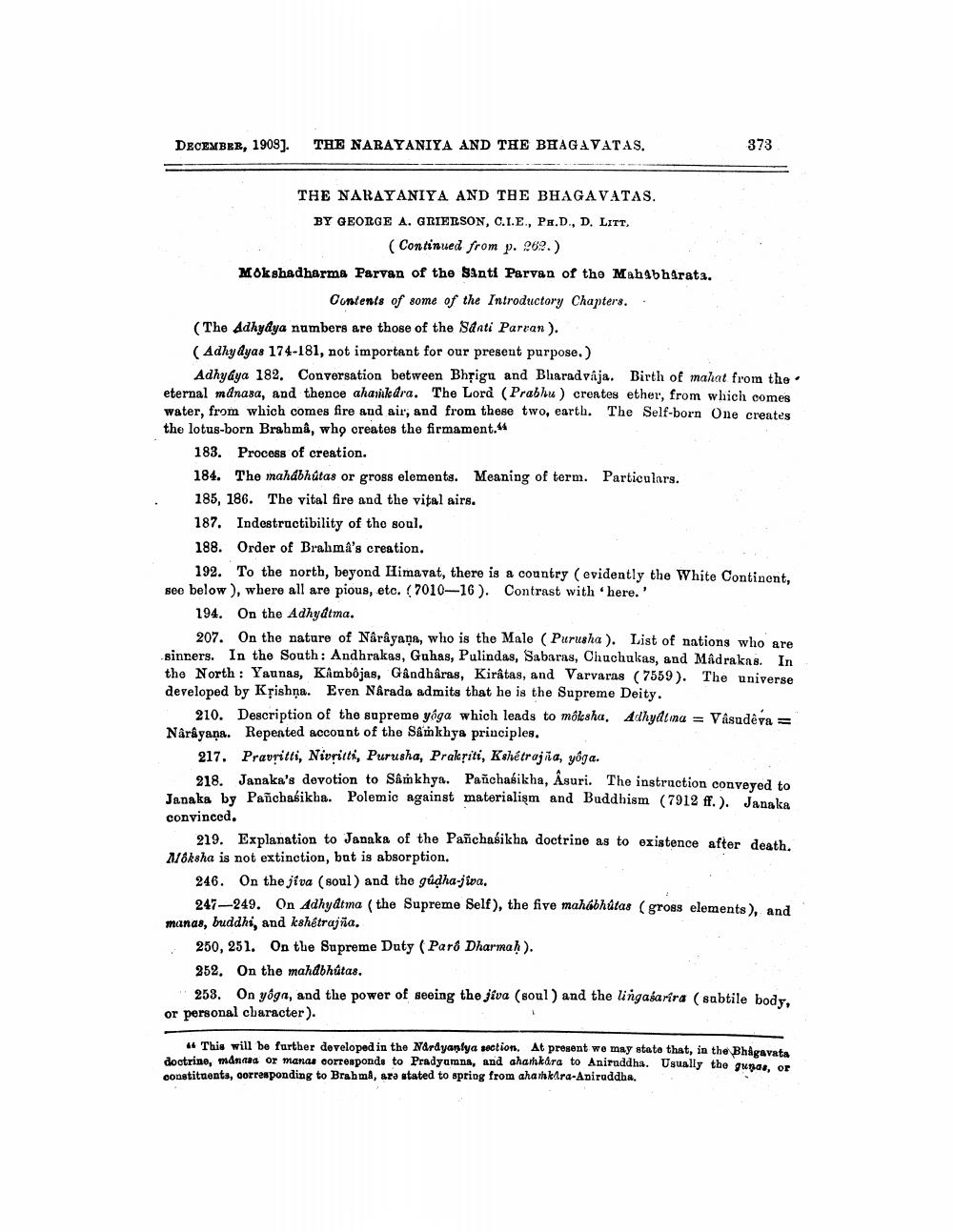________________
DECEMBER, 1909).
THE NARAYANIYA AND THE BHAGAVATAS.
373
THE NARAYANIYA AND THE BHAGAVATAS. BY GEORGE A. GRIERSON, C.I.E., Ph.D., D. LITT,
(Continued from p. 269.) Mókshadharma Parvan of the Santi Parvan of tho Mahabharata.
Contents of some of the Introductory Chapters.. (The Adhydya numbers are those of the Santi Parran). (Adhy dyas 174-181, not important for our present purpose.)
Adhyâya 182. Conversation between Bhrigu and Bharadvaja. Birth of mahat from the eternal mdnasa, and thence ahankdra. The Lord (Prabhu ) creates ether, from which comes water, from which comes fire and air, and from these two, earth. The Self-born One creates the lotus-born Brahma, who creates the firmament."
183. Process of creation. 184. The mahabhūtas or gross elements. Meaning of term. Particulars. 185, 186. The vital fire and the vital airs. 187. Indestructibility of the soul. 188. Order of Brahmi's creation.
192. To the north, beyond Himavat, there is a country (evidently the White Continent, see below), where all are pious, etc. (7010-16). Contrast with here.'
194. On the Adhyatma.
207. On the nature of Narayana, who is the Male (Purusha). List of nations who are sinners. In the South: Andhrakas, Guhas, Pulindas, Sabaras, Chuchukas, and Madrakis. In the North : Yaunas, Kimbôjas, Gândháras, Kirâtas, and Varvaras (7559). The universe developed by Krishna. Even Närada admits that he is the Supreme Deity.
210. Description of the supreme yôga which leads to móksha. Alhydıma = Vasudeva = Narayana. Repented account of the Sámkhya principles.
217. Pravritti, Nivritti, Purusha, Prakriti, Kshetrajña, yoga.
218 Janaka's devotion to Samkhya. Pañchasikha, Asuri. The instruction conveved to Janaka by Panchaśikha. Polemic against materialism and Buddhism (7912 ff.). Janska convinced.
219. Explanation to Janaka of the Panchasikha doctrine as to existence after death. Móksha is not extinction, but is absorption.
246. On the jiva (soul) and the gudha-jiva.
247-249. On Adhyatma ( the Supreme Self), the five mahábhutas (gross elements), and manas, buddhi, and kshetrajña.
250, 251. On the Supreme Duty (Parð Dharmah). 252. On the mahābhūtas.
258. On yoga, and the power of seeing the jiva (soul) and the lingasarira (subtile body, or personal character).
** This will be further developed in the Nardyanya section. At present we may state that, in the Bhagavata doctrine, manuaa or manas corresponds to Pradyumna, and ahamkára to Aniruddha. Usually the gunas, or constituents, corresponding to Brahma, era stated to spring from ahankara-Aniruddha.




